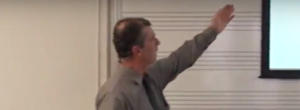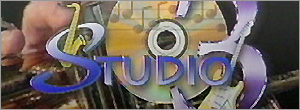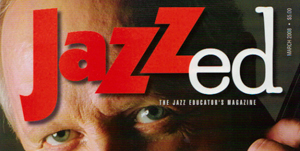
By Chet Williamson:
The product of two well-known and influential Boston-area musicians, pianist, arranger, and singer Paul Broadnax was born a child of destiny. His own successful life in music has proven to be a dream fulfilled.
Born in Cambridge, MA on January 27, 1926, Broadnax's musical world literally began, as he put it, "In-vitro; my mom and dad were both classical musicians and were very active in the community. They both came from large families in which my grandparents and many of my aunts and uncles were professional musicians. I heard music all the time." (Owens)
Both parents were professional singers. His father, Paul Leo Broadnax, Sr. was from Haverill, MA and sang in the Lyric Male Quartet. His mother, Rebecca Ellastine (Lee), was originally from North Carolina and later resided in Providence, RI. She was a soprano soloist, voice teacher, and choir director.
"My dad was a tenor. Lead most of the time," Broadnax recalled. "The quartet performed all over New England. They were doing mostly spirituals, some show tunes. Not too far out. They had to stay respectable." (Falco)
"They had great voices. I can remember lying in my bed supposedly sleeping and they were rehearsing in the next room. This guy named Gilbert Harvey. He had such a bass voice. That thing would shake the house." (Falco)
Although, Broadnax, Sr., was known to offer some voice coaching from time to time, he did not teach formally. It was young Paul's mother who established that as a vocation. In fact, for more than 50 years she was one of the more influential voice teachers in Boston. So much so a prestigious scholarship was established in her honor.
"My mom was the only girl in a family of eight people with seven brothers," Broadnax said. "One brother (Joseph, aka Joe Lee) was a great stride pianist. Another uncle had an incredible tenor voice. He did a lot of church work in New York City. Everybody had some talent. You couldn't help it. You were born into this community with a musical overlay and you just had to take part." (Falco)
Broadnax described his mother as a "go getter," who took music classes at Harvard and Brown. "She would study music courses at all these different colleges," he said. "She became quite proficient with her singing and directing." (Falco)
Mrs. Ellastine Broadnax is the founder of a neighborhood chorus group called the Cant emus Club, which means, "Let us sing." "We did lot's of operettas, chorus work," Paul Broadnax recalled. "We even did shortwave radio. So you could have your material played all over the world." (Falco)
The group also performed in concerts at the New England Conservatory, John Hancock Hall, and many of the churches around Greater Boston. It was popular ensemble that had no trouble attracting members. "They were contemporaries of mine," Broadnax said of its members. "People would come running. It was no problem at all spreading the word." (Falco)
Paul has two sisters and a brother who were also musicians. Leona played violin. Rebecca sang, and brother, Benny played the drums. Paul was the only sibling to play professionally.
In addition to studying voice with his mother, Broadnax took piano lesson from age eight to 14 at the Ebenezer Baptist Church with concert pianist Ina Payne Braithwaite. "She was a great solo artist and also a violinist," Broadnax said. "She did a lot of public appearances." Broadnax said Braithwaite was a friend of his mother, who was also a seamstress. "My mother bartered with her to keep her in gowns and whatever else she needed. That's how I got my piano lessons. I can't thank mom enough for that."
(Falco)
In 1987 The Broadnax Scholarship Fund was established as a memorial to Ellastine Broadnax. "Mrs. B.," as she was called, opened the Broadnax Studio in her home in the early 1930s. According to the Broadnax family, Ellastine was "always involved with music and young people, she coached vocalists, pianists, church choirs and choral groups. Teenagers were trained not only to sing, read music and play instruments, but also harmony and solfeggio. She prepared them to perform professionally on stage and radio, in concerts and recitals." (Owens)
Broadnax told writer Barbara Owens: "We are proud that, since 1987 when our mother died, the family and our donors have presented more than thirty $500 Achievement Awards to encourage deserving students at Roland Hayes School of Music (RHSM) which is part of Madison Park High School in Boston. For more details on the fund, see:
(Owens)
As a child, Broadnax and family moved to Roxbury, where he, "spent just about all of my youth." Historically seen as one of the oldest neighborhoods in Boston, Roxbury continues to enjoy its close proximity to downtown. Its early inhabitants were a mixture of English, Irish and German immigrants, but in the 1930s, following the great migration of southern blacks north, Roxbury became the hub of African-American life in New England.
The importance of this relocation for Broadnax in his development as a professional musician cannot be overstated. In addition to being schoolmates with such future notable jazz stars as Roy Hayes, Alan Dawson and Ray Perry, Roxbury was home to guitarist Irving Ashby, bandleader Sabby Lewis, and Elma Lewis, the founder of the National Center of African-American Artists.
"In Junior High School (Lewis School, Roxbury, MA) I studied clarinet so I could play in the marching band," Broadnax said. "I started my own band during this time. Some of my players went on to become famous jazz musicians." (Falco)
Modeling themselves after the Nat Cole trio, the group began entertaining audiences at churches, school dances and the Roxbury USO. In 1943, Broadnax also started playing the tenor saxophone and studied privately with Big Nick Nicholas, a star soloist with the Sabby Lewis Band.
After high school (Mechanic Arts High School, Boston, MA), Broadnax's musical career was put on hold in 1944 when he entered the Army Air Corps, where he met arranger/pianist Donn Trenner, who collaborated with Broadnax on his future CD, Here's to Joe, a musical tribute to singer Joe Williams.
"I was drafted," Broadnax said in an interview with writer Barbara Owens. "I reported to Fort Devens and in a few days shipped out to Texas. I was a foot soldier for two days. Then I was picked up in a staff car, taken to headquarters and assigned to Special Services as a musician. I couldn't understand my good fortune." (Owens)
It wasn't until many years later that Broadnax was given the reason.
"In 1980, I was shopping with my dad and an old gent walked by," he said. "I recognized him as the Director of the USO in Roxbury. I spoke to him and in the course of conversation he asked me, 'What happened in the service?' I said that I had been assigned to Special Services. His response was 'Good, it worked.' I was totally unaware until that moment that because of his contacts with the military, his phone call had sent me to Special Services." (Falco)
According to the National Association of Music Merchants Donn Trenner was one of the most successful pianists in the big band and bebop eras. In 1943, he began his career with the popular Ted Fio Rito Orchestra. He later played with bands led by Buddy Morrow, Charlie Barnet and Jerry Gray. "As the bop era developed, Trenner played alongside innovators including Charlie Parker and Stan Getz, but may be best known to millions of popular music fans as the pianist behind such singers Lena Horne, Anita O'Day, Ann-Margaret, and Nancy Wilson. Trenner also led the house band for the Steve Allen Show on NBC." Broadnax and Trenner remain friends to this day. (NAAM)
After the war, Broadnax returned to Roxbury and picked up where he had left off, jumping back into the music, hooking up with alto saxophonist Harold Emerson, trumpeter Buster Daniels and tenor saxophonists Doug Lee and Fred Williams.
Broadnax describes Roxbury at the time simply as a city that resonated with the sound of jazz. Telling Owens that the jazz clubs he frequented in Boston were wonderful. "The Savoy, Wally's Paradise, The Big M, Eddie's Lounge and the Hi Hat to name a few. All featured name musicians and I had a chance to play with some. I heard Sarah Vaughan, Cab Calloway, Dizzy, Errol Garner and so many others. Also the big theaters featured great movies and live stage music – usually the big swing and jazz bands including Basie, Goodman, Dorsey and Ellington." (Falco)
Like Cole, whose sophisticated style influenced Broadnax piano, Ellington would become a mighty force in the young artist's development.
In an interview he gave to WFCR jazz programmer and writer Tom Reney for the Boston Globe, Broadnax said, "We took great pride in Ellington, whom I met but mostly adored from afar. This was still a time of extreme segregation, and very few jobs were available for black musicians on the local hotel dance scene. Most of the work for us was in the nightclubs around Columbus and Mass Ave., the Savoy, the Hi-Hat, Eddie's, Wally's Paradise." ("Jazz A La Mode")
In fact, the racial climate of the times required that there be two musician's unions in Boston -- one for whites (Local 9); the other for blacks (Local 535.) The two unions did not merge until the 1970s to become the Local 9-535.)
Continuing with his admiration for the Duke, Broadnax said, "Ellington was first class, and he played those top spots. The band always looked great, they wore beautiful tuxes, nothing rag-tag, and the music just blew our minds. But the social thing was very important. Duke gave us a great feeling." (Owens)
In the late 1940s, Broadnax began writing arrangements for Sabby Lewis, a bandleader whose stature in Boston was akin to Ellington's nationally. The Lewis bands were incubators for those of the major leagues. Some of the many who traveled through the ranks to become future jazz stars include Alan Dawson, Big Nick Nicholas, Bobby Donaldson, Roy Haynes, Leon Merrian, Sonny Stitt and Paul Gonzalves, among others.
According to his obituary in the New York Times, William Sebastian Lewis, a pianist and band leader who performed with Billie Holiday, organized his first band in Boston in 1936. "He later performed on Broadway and in ballrooms and clubs in Manhattan. Other jazz stars he performed with included Dinah Washington and Billy Eckstine. In the 1950s, Mr. Lewis became Boston's first black disk jockey when he went to work at WBMS." (New York Times)
Broadnax supplied arrangements for Lewis and company for more than five years.
He had the good fortune to be there when tenor saxophonist Paul Gonsalves was its star attraction. This was before the New Bedford native received the call to join the Duke Ellington orchestra.
Broadnax recalls Lewis as Boston's premier black bandleader and Gonsalves as: "an incredible player who could lift that whole band. He had such a great sound, and he was full of ideas, very, very advanced." (Falco)
In addition to supplying arrangements for Lewis, directing his own groups and working with the Tom Kennedy and Buster Daniels bands, he played tenor, piano and sang with the Gilmore Big Band, all the while writing arrangements for the group. Broadnax also found time to go back to school, earning an engineering degree at Northeastern University.
Although engineering would dominate his daytime career throughout the 1950s into the '80s, Broadnax continued to pursue the jazz night life. For more than 15 years he co-led the popular Paul Champ Three, featuring bassist Champlain "Champ" Jones and drummer Tony Sarni. The group recorded one album, Introducing the Paul-Champ Three. At one point in the 1960s, the trio enjoyed a regular spot on the ABC-TV station affiliate in Boston. In 1981, Broadnax formed a new trio with bassist Dave Trefethen and drummer Les Harris, Jr. This group performed in concerts, nightclubs and on radio and television.
Over the years, Broadnax's ensembles have appeared with many nationally recognized jazz artists including Cab Calloway, Dorothy Donnegan, Lionel Hampton, Clark Terry, Joe Williams, and Jimmy Witherspoon, among others.
Terry is quoted as saying this about Broadnax: "Aside from a magnificent pianist and accompanist, Paul is a gentleman, a credit to the profession, and a major force in the perpetuation of the craft of jazz. Those who appreciate talent will wonder where he's been." (http://www.paulbroadnax.com/press.html)
As Broadnax contemplated retirement from the world of engineering he also became excited about the notion of once again becoming a fulltime musician. Since leaving the corporate world for the nightlife, Broadnax has been busier than ever.
His non-stop career has gathered national acclaim, touring highlights, and numerous albums to his credit. His present trio consists of Peter Kontrimas on bass and Dave Trefethen now on guitar.
It was a longtime coming, but in 1994 Broadnax finally released an album under his own name. Music writer Dave Nathan in Jazziz reviewed the disc, stating, "In the tradition of the great baritones like Johnny Hartman, Joe Williams, Billy Eckstine, and Nat King Cole comes Paul Broadnax with his first album, It's About Time. And about time it is. Having labored in the jazz vineyards for more than 50 years by the time this album was cut, Broadnax makes the most of this opportunity, taking on an ambitious and varied musical agenda of 16 songs … By providing a taste of all types of jazz singing on his first solo album, Broadnax seems to be saying to those in charge of producing jazz albums, 'Look at what you've been missing all these years.'
"This album is no amateur hour, but rather the output of a talented, professional singer who understands that the essence of vocalizing is communicating in a manner that grabs and retains the attention of the listener. Although Broadnax brings to mind the great male singers of the past, he apes none of them and possesses his own unique approach to the music. Featuring excellent and sympathetic musical accompaniment, this album is more than an hour's worth of fine jazz music."
One of the highlights of his long and storied career is the 1996 recording for the Worcester's Brownstone label. Called Here's to Joe, a tribute to Joe Williams, the album received national airplay, positive critical review and a warm grateful reception from its subject. "I'm glad he happened along in our time because he gives the listener so much pleasure," Williams stated. "I feel like I'm passing the torch."
Speaking of Broadnax told writer Owens that he loved his voice, style, choice of tunes and the musicians he used. "I've been listening to him ever since the Basie days in the 50's. Since 1989 I have been a passenger on many jazz cruises where Joe was featured. It took two or three cruises before I met him and it was well worth the wait.
"I decided to do a tribute to Joe and sent a rough copy of the CD, Here's To Joe, for his approval. The CD included music he made 'his own.' We met him at the Regattabar in Cambridge; it was the first time we made contact since he heard the rough copy. He gave me a bear hug and said, 'Go with it, baby.' There have been many highlights in my musical career: this was one of them."
Bob Blumenthal, one of the deans of Boston jazz critics, said of the disc, "For his part, Paul Broadnax did just what is called for when a dream comes true. He rose to the occasion, investing every bit of passion and musicality into the final result. The results works the way a tribute should, giving Joe his due, while adding to Paul's own stature as a definitive vocalist in the jazz idiom." (Blumenthal)
Through the experience, Broadnax and Williams became close friends right up to the time of Williams' untimely death in 19XX? Other albums to Broadnax burgeoning credit include Friends, Live At Indian Hill Music, and Strike Up The Band, featuring Fred Haas on saxophone.
He has also appear on other's recording, namely, Jeanne Lee's, Natural Affinities, The Kenny Hadley Big Band's Come Sunday, Greg Abate's It's Christmas Time, and Monica Hatch's If You Never Come To Me, and Wendee Glick's, Baby I'm Fine.
* Just recorded a track "Baby It's Cold Outside," on Rebecca Parris' latest CD.
In describing the artistry of Broadnax, music critic Dave Nathan wrote: "Blessed with a smooth, silky baritone in the mold of Joe Williams, Johnny Hartman, and Earl Coleman, Broadnax had to work the boards for far too many years before getting his recording chance. As his solo albums attest, it was a long wait, but worth it." (Nathan)
Know for his "King Thing," for channeling of Nat Cole, Broadnax continues to perform through New England. He has twice been nominated for the Boston Music Awards Jazz Singer of the Year.
Like Cole, Broadnax sings and accompanies himself on piano. He has appeared in virtually every jazz venue throughout the New England area. Some of the many rooms include, Sculler's Jazz Club, the Westin Hotel, the Carriage Stall, the Gallery Hatch, and Ephraims, as well as, the Bay Tower, 60 State Street in Boston, Michael Timothy's in Nashua, The Caravan in Revere, the Firehouse in Newburyport (where he appeared with Herb Pomeroy), Luka's Greenhouse Restaurant in Hampton Falls in New Hampshire, and his longstanding Monday night residency (15-year stint) at Bullfinch's Restaurant in Sudbury.
Broadnax and his music have appeared on radio and television, in commercials, corporate and industrial films. He has appeared in concert and festivals such those in Brockton and Winthrop, ME and at Portsmouth, NH. In 1992, Broadnax performed at Lionel Hampton's festival in Moscow, ID. He also graced the stage at the Jazz in the Movies Festival in Melrose with guitarist Gray Sargent and bassist Marshall Wood (currently touring with Tony Bennett.)
In a review of his appearance on the Holland-America Line Jazz Cruise, writer Janet Palmer of the Columbus Dispatch wrote: "When Paul Broadnax plays piano and sings, you reach for a hand to hold. Among the 100-plus players on board the S.S. Norway for its 15th annual floating jazz festival, Broadnax became a favorite." (Palmer)
In 2003, Broadnax was chosen as Musician of the Year by the Boston Musicians' Association. And, to this day, continues to flourish.
Often times prevailed upon to appear in the Duke Ellington Sacred Concerts, Broadnax recently appeared in a performance at the First Congregational Church in Manchester. And, in a letter to Broadnax sent from Kenneth Grinnell, minister of music, he asks: "How can I thank you enough for bringing your skill, talent, and enthusiasm for the Duke Ellington gig we did last April? You were magnificent and helped the evening be the success it was. I have said (to many people), that anyone present that night came away a changed person." (Grinnell)
Writer Owens once asked, Broadnax to describe his own inimitable style. He said, "I have always stayed true to what I do and never watered down my music in order to be commercial success. Music is my heart." (Owens)
Primary Sources:
- Broadnax, Paul. Interview with Tom Reney. "Jazz a la Mode". WFRC Radio, Amherst, MA. 26 Dec.1999.
- Falco, Richard. Personal interview with Paul Broadnax. 16 Nov. 2012
- Grinnell, Ken. "Letter to Paul Braodnax". MS.
- Owens, Barbara. Interview with Paul Broadnax. www.paulbroadnax.com/bma.htm. Print.
- Trenner, Don.Don Trenner. Interview with Don Trenner. NAAM. Web. 2 Feb.2004. Video.
Other Sources:
- Blumenthal, Paul. "Paul Braodnax-Here's to Joe CD". JazzTimes March 1997, p.96. Print
- http://www.paulbroadnax.com/press.html
- Nathan, David. "Paul Braodnax". All Music. p165162.
- New York Times. 14 July 1994.
- Palmer,Janet. The Columbus Dispatch. Print.







